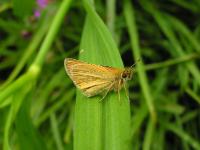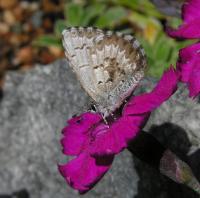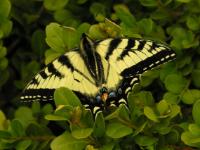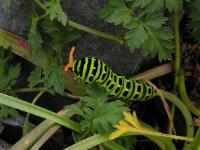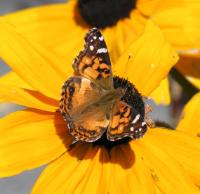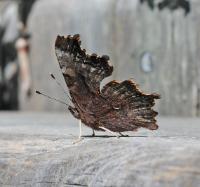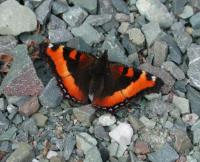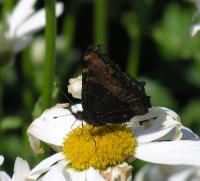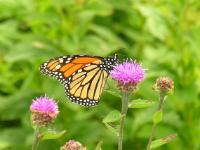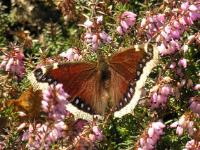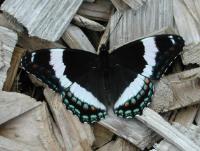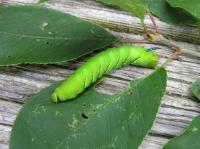Butterflies, Moths, & Skippers

What is the difference between butterflies, moths, and skippers?
Butterflies: drink and rest with their wings up, but sun themselves with their wings outstretched. They have smooth antennae with a knob at the end. Their body hardens into a chrysalis for metamorphosis. They are active in the daytime. Some can be quite colourful.
Moths: rest with their wings outstretched along their back, or tented. Have feathery antennae. They spin a cocoon with silk for metamorphosis, and some species are active during the night, while others are active during the day. They are usually muted colours. Their bodies are usually fuzzier and plumper than that of butterflies.
Skippers: are often considered a mix of butterflies and moths. They rest usually with their wings angled upwards, sometimes outstretched, although parted, and rarely completely folded upwards. Like butterflies, they are active during the day, and have smooth antennae with a club end, although the club is often hooked. Like moths they are often a muted colour, often have plumper bodies, and spin a cocoon for metamorphosis.
Newfoundland and Labrador have 55 butterfly species of the 293 found in Canada.
Families
- Skippers (Hesperiidae)
- Blues and Coppers (Lycaenidae)
- Swallowtail Butterflies (Papilionidae)
- Brushedfoot Butterflies (Nymphalidae)
- Sulphurs and Whites (Pieridae)
- Owlet Moths & Miller Moths (Noctuidae)
- Erebid Moths (Erebidae)
- Crambid Snout Moths (Crambidae)
- Pterophorid Moths, Plume Moths (Pterophoridae)
- Geometer Moths, Looper Moths (Geometridae)
- Hawk moths, sphinx moths, and hornworms (Sphingidae)
List of Butterflies and Skippers* and some Moths
Skippers (Hesperiida)
Class Name: Arctic or Chequered Skipper
Scientific Name: Carterocephalus palaemon
Found in (N=Newfoundland, L=Labrador): NL
Host Plant: Purple Reedgrass, Bromes
Nectar Source: Flowers including iris
Class Name: Common Branded/Labrador Skipper
Scientific Name: Hesperia comma
Found in (N=Newfoundland, L=Labrador):
Host Plant: Various grasses and sedges
Nectar Source: Nectar from many flowers including asters, goldenrods, and blazing star
Class Name: European Skipper
Scientific Name: Thymelicus lineola
Found in (N=Newfoundland, L=Labrador): N (rare)
Host Plant: Timothy (Phleum pratense) and other grasses
Nectar Source: Low-growing flowers including orange hawkweed, thistles, ox-eye daisy, fleabane, white clover, red clover, selfheal, Deptford pink, common milkweed, and swamp milkweed
Class Name: Grizzled Skipper
Scientific Name: Pyrgus centaureae
Found in (N=Newfoundland, L=Labrador): NL
Host Plant: Wild strawberry, Canadian cinquefoil, varileaf cinquefoil, and cloudberry; all in the rose family
Nectar Source: Nectar from flowers of low-growing plants including blueberry, wild strawberry, and Canadian cinquefoil
Class Name: Peck's Skipper
Scientific Name: Polites peckius
Found in (N=Newfoundland, L=Labrador): NL
Host Plant: Rice cutgrass; probably bluegrass and others
Nectar Source: Red clover, purple vetch, thistles, selfheal, blue vervain, common milkweed, swamp milkweed, dogbane, and New Jersey tea
Blues & Coppers (Lycaenidae)
Class Name: Arctic Blue
Scientific Name: Agriades glandon
Found in (N=Newfoundland, L=Labrador): NL
Host Plant: Diapensia lapponica, Dodecatheon, and Androsace septentionalis
Nectar Source: Flower nectar
Class Name: Bog Copper
Scientific Name: Lycaena epixanthe
Found in (N=Newfoundland, L=Labrador): N
Host Plant: Shrubby cranberries in the heath family
Nectar Source: Water from raindrops and nectar from cranberry flowers
Class Name: Brown Elfin
Scientific Name: Callophrys augustinus
Found in (N=Newfoundland, L=Labrador): NL
Host Plant: Heath family, including sugar huckleberry and Labrador tea. In the west, many other plants including madrone and dodder
Nectar Source: Blueberry and willow
Class Name: Dorcas Copper
Scientific Name: Callophrys augustinus
Found in (N=Newfoundland, L=Labrador): NL
Host Plant: Shrubby Cinquefoil
Nectar Source: Balck-eyed Susan
Class Name: Greenish Blue
Scientific Name: Plebejus saepiolus
Found in (N=Newfoundland, L=Labrador): L
Host Plant: Flowers of various clovers
Nectar Source: Flowers of various clovers
Class Name: Northern Blue
Scientific Name: Lycaeides idas
Found in (N=Newfoundland, L=Labrador): NL
Host Plant: Plants of the heath family (Ericaceae) in the east; legumes of the pea family (Fabaceae) in the west
Nectar Source: Yarrow, dogbane, orange hawkweed, and white, alsike, and hop clover
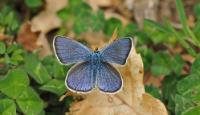
Class Name: Silvery Blue
Scientific Name: Glaucopsyche lygdamus
Found in (N=Newfoundland, L=Labrador): NL
Host Plant: Astragalus, Lotus, Lupinus, Melilotus, Oxytropis, Lathyrus, Vicia, and other species in the pea family
Nectar Source: Shrubby cinquefoil and other cinquefoils
Class Name: Spring Azure
Scientific Name: Celastrina ladon
Found in (N=Newfoundland, L=Labrador): NL
Host Plant: Woody shrubs and occasionally herbs including dogwood, New Jersey tea, meadowsweet, and Collinsia
Nectar Source: Dogwood, dogbane, privet, New Jersey tea, blackberry, common milkweed, and many others
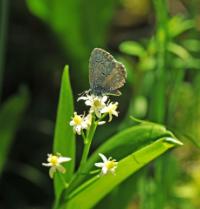
Swallowtail Butterflies (Papilionidae)
Class Name: Canadian Tiger Swallowtail
Scientific Name: Papilio canadensis
Found in (N=Newfoundland, L=Labrador): N
Host Plant: Leaves of birch (Betula), aspen (Populus), and black cherry (Prunus)
Nectar Source: Joe-Pye weed, Blazingstar, Bergamot, Willow, and Ironweed
Class Name: Short-tailed Swallowtail
Scientific Name: Papilio brevicauda
Found in (N=Newfoundland, L=Labrador): NL
Host Plant: Angelica, cow-parsnip, Scotch lovage, milkweed
Nectar Source: Angelica, cow-parsnip, Scotch lovage, milkweed
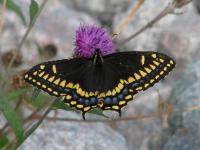
Brushedfoot Butterflies (Nymphalidae)
Class Name: American Lady
Scientific Name: Vanessa virginiensis
Found in (N=Newfoundland, L=Labrador): NL
Host Plant: Sunflower family, pearly everlasting
Nectar Source: Dogbane, aster, goldenrod, marigold, selfheal, and vetch
*Do not confuse with Painted Lady Butterfly*
Class Name: Atlantis Fritillary
Scientific Name: Speyeria atlantis
Found in (N=Newfoundland, L=Labrador): NL
Host Plant: Violets
Nectar Source: Mints, mountain laurel, crown vetch, burdock, boneset, ox-eye daisy, and spiraea
Class Name: Bog Fritillary
Scientific Name: Boloria eunomia
Found in (N=Newfoundland, L=Labrador): NL
Host Plant: Willow (Salix), alpine smartweed (Polygonum viviparum), and violets (Viola)
Nectar Source: Labrador tea and goldenrod
Class Name: Common Ringlet
Scientific Name: Coenonympha tullia
Found in (N=Newfoundland, L=Labrador): NL
Host Plant: Grasses and rushes
Nectar Source: Flower Nectar
Class Name: Compton Tortoiseshell
Scientific Name: Nymphalis vaualbum
Found in (N=Newfoundland, L=Labrador): N
Host Plant: Aspen and cottonwood (Populus), willows (Salix), gray birch (Betula populifolia), and paper birch (B. papyrifera)
Nectar Source: Sap, rotting fruit, nectar of willow flowers
Class Name: Eastern Comma
Scientific Name: Polygonia comma
Found in (N=Newfoundland, L=Labrador): N
Host Plant: All members of the elm and nettle families including American elm, hops, nettle, false nettle, and wood nettle
Nectar Source: Rotting fruit and tree sap
Class Name: Freija Fritillary
Scientific Name: Boloria freija
Found in (N=Newfoundland, L=Labrador): NL
Host Plant: Dwarf bilberry (Vaccinium caespitosum) and other plants in the heath family (Ericaceae)
Nectar Source:
Class Name: Frigga Fritillary
Scientific Name: Boloria frigga
Found in (N=Newfoundland, L=Labrador): L
Host Plant: Cranberry (Vaccinium) and bog rosemary (Andromeda), perhaps willow (Salix) and dwarf birch (Betula)
Nectar Source:
Class Name: Gray Comma
Scientific Name: Polygonia progne
Found in (N=Newfoundland, L=Labrador): N
Host Plant: Gooseberries (Ribes) and azalea (Rhododendron)
Nectar Source: Sap; rarely flower nectar
Class Name: Green Comma
Scientific Name: Polygonia faunus
Found in (N=Newfoundland, L=Labrador): NL
Host Plant: Small pussy willow, black birch, alder, western azalea, and gooseberry
Nectar Source: Flower nectar, dung, carrion
Class Name: Hoary Comma
Scientific Name: Polygonia gracilis
Found in (N=Newfoundland, L=Labrador): L
Host Plant: Currants and gooseberries, western azalea, and mock azalea
Nectar Source: Sap and nectar from flowers of sweet everlasting
Class Name: Jutta Arctic
Scientific Name: Oeneis jutta
Found in (N=Newfoundland, L=Labrador): NL
Host Plant: Sedges, including cottongrass
Nectar Source: Flower nectar
Class Name: Meadow Fritillary
Scientific Name: Boloria bellona
Found in (N=Newfoundland, L=Labrador): L
Host Plant: Violets
Nectar Source: Composites, black-eyed susans, dandelions, and ox-eyed daisy
Class Name: Melissa Arctic
Scientific Name: Oeneis melissa
Found in (N=Newfoundland, L=Labrador): L
Host Plant: Sedges including Carex bigelowii and C. rupestris
Nectar Source:
Class Name: Milbert's Tortoiseshell
Scientific Name: Nymphalis milbereti
Found in (N=Newfoundland, L=Labrador): NL
Host Plant: Nettles
Nectar Source: Thistles, goldenrods, and lilacs; sap and rotting fruit
Class Name: Monarch
Scientific Name: Danaus plexippus
Found in (N=Newfoundland, L=Labrador): N (accidental)
Host Plant: Milkweed (not native to Newfoundland)
Nectar Source: Milkweeds, dogbane, lilac, red clover, thistles, and goldenrods
Class Name: Mourning Cloak
Scientific Name: Nymphalis antiopa
Found in (N=Newfoundland, L=Labrador): NL
Host Plant: Willows, American elm, cottonwood, aspen, paper birch
Nectar Source: Prefer tree sap, especially of oaks. Will feed on rotting fruit, and rarely flower nectar
Class Name: Northern Crescent
Scientific Name: Phyciodes cocyta
Found in (N=Newfoundland, L=Labrador): NL
Host Plant: Asters, in the sunflower family (Asteraceae)
Nectar Source: Flowers of dogbane, fleabane, and white clover
Class Name: Painted Lady
Scientific Name: Vanessa cardui
Found in (N=Newfoundland, L=Labrador):
Host Plant: More than 100 host plants have been noted; favorites include thistles, hollyhock, mallow, and various legumes
Nectar Source: Prefers nectar from composites 3-6 feet high, especially thistles; aster, cosmos, blazing star, ironweed, and joe-pye weed. Flowers from other families that are visited include red clover, buttonbush, privet, and milkweeds
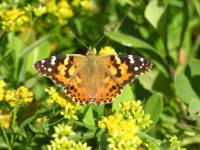
Class Name: Polaris Fritillary
Scientific Name: Boloria polaris
Found in (N=Newfoundland, L=Labrador): L
Host Plant:
Nectar Source:
Class Name: Polixenes Arctic
Scientific Name: Oeneis polixenes
Found in (N=Newfoundland, L=Labrador): NL
Host Plant: grasses and sedges
Nectar Source:
Class Name: Question Mark
Scientific Name: Polygonia interrogationis
Found in (N=Newfoundland, L=Labrador): N
Host Plant: nettles and elms
Nectar Source: Rotting fruit, tree sap, dung, carrion. Only when these are unavailable do Question Marks visit flowers such as asters
Class Name: Red Admiral
Scientific Name: Vanessa atalanta
Found in (N=Newfoundland, L=Labrador): NL
Host Plant: Nettles
Nectar Source: Prefer sap flows, fermenting fruit, and bird droppings; visiting flowers only when these are not available. Then they will nectar at red clover, aster, and alfalfa
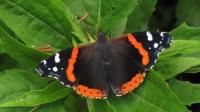
Class Name: Ross' Alpine
Scientific Name: Erebia rossii
Found in (N=Newfoundland, L=Labrador): L
Host Plant:
Nectar Source:
Class Name: Satyr Comma
Scientific Name: Polygonia satyrus
Found in (N=Newfoundland, L=Labrador): N
Host Plant: Nettles
Nectar Source: Tree sap, rotting fruit, blackberry flower nectar
Class Name: Silver-boarded Fritilliary
Scientific Name: Boloria selene
Found in (N=Newfoundland, L=Labrador): NL
Host Plant: Violets
Nectar Source: Goldenrod and black-eyed susans

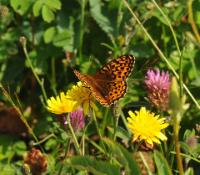
Class Name: Taiga Alpine
Scientific Name: Erebia mancinus
Found in (N=Newfoundland, L=Labrador): L
Host Plant: Grasses or sedges
Nectar Source:
Class Name: White Admiral
Scientific Name: Limenitis arthemis
Found in (N=Newfoundland, L=Labrador): NL
Host Plant: Pin cherry aspen, poplar, oaks, hawthorn, birch, willows, and chuckley pear
Nectar Source: Sap, rotting fruit, carrion, dung, and occasionally nectar from small white flowers including spiraea, privet, and viburnum. White Admirals also sip aphid honeydew
Class Name: White Veined Arctic
Scientific Name: Oeneis bore
Found in (N=Newfoundland, L=Labrador): L (accidental)
Host Plant: Grasses or sedges
Nectar Source:
Sulphurs and Whites (Pieridae)
Class Name: Clouded Sulphur
Scientific Name: Colias philodice
Found in (N=Newfoundland, L=Labrador): N
Host Plant: Plants in the pea family (Fabaceae) including alfalfa (Medicago sativa), white clover (Trifolium repens), and pea (Pisum sativum)
Nectar Source: Flower nectar of many plants
Class Name: Hecla Sulphur
Scientific Name: Colias hecla
Found in (N=Newfoundland, L=Labrador): L
Host Plant:
Nectar Source:
Class Name: Labrador Sulphur
Scientific Name: Colias nastes
Found in (N=Newfoundland, L=Labrador): L
Host Plant: Plants of the pea family including milk vetch and white clover
Nectar Source:
Class Name: Mustard White
Scientific Name: Pieris oleracea
Found in (N=Newfoundland, L=Labrador): NL
Host Plant: Mustard family plants
Nectar Source: Mustard family plants
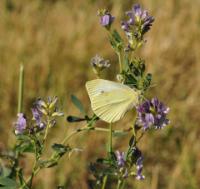
Class Name: Orange Sulphur
Scientific Name: Colias eurytheme
Found in (N=Newfoundland, L=Labrador): N
Host Plant: Pea family plants and white clover
Nectar Source: Dandelion, goldenrods, and asters
Class Name: Palaeno Sulphur
Scientific Name: Colias palaeno
Found in (N=Newfoundland, L=Labrador): L
Host Plant:
Nectar Source:
Class Name: Pelidne Sulphur
Scientific Name: Colias pelidne
Found in (N=Newfoundland, L=Labrador): NL
Host Plant: Blueberries, wintergreen, and heaths
Nectar Source:
Class Name: Pink-edged Sulphur
Scientific Name: Colias interior
Found in (N=Newfoundland, L=Labrador): NL
Host Plant: Blueberries and heaths
Nectar Source: Orange hawkweed
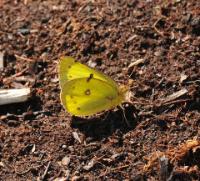
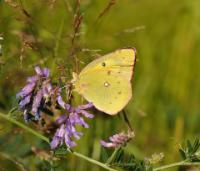
Class Name: Cabbage White
Scientific Name: Pieris rapae
Found in (N=Newfoundland, L=Labrador): N
Host Plant:Leaves or buds of: cabbage, brussel sprouts, Bok Choy, kale, beets
Nectar Source: Mustards, dandelion, red clover, asters, and mints
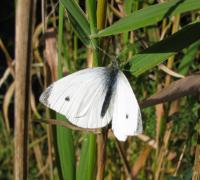
Owlet Moths & Miller Moths (Noctuidae)
Class Name: Fingered Dagger Moth
Scientific Name: Acronicta dactylina
Found in (N=Newfoundland, L=Labrador): N
Host Plant: Alders, birches, poplars, and willows
Nectar Source:
Class Name: Intermediate Cucullia
Scientific Name: Cucullia intermedia
Found in (N=Newfoundland, L=Labrador): N
Host Plant: Wild lettuce
Nectar Source:
Class Name: Two-spotted Looper Moth
Scientific Name: Autographa bimaculata
Found in (N=Newfoundland, L=Labrador): N
Host Plant:
Nectar Source:
Class Name: Wavy Chestnut Y Moth
Scientific Name: Autographa mappa
Found in (N=Newfoundland, L=Labrador): N
Host Plant: Nettles and blueberries
Nectar Source:
Class Name: Formosa Looper Moth
Scientific Name: Chrysanympha formosa
Found in (N=Newfoundland, L=Labrador): N (rare)
Host Plant: Blueberry and dwarf huckleberry
Nectar Source:
Class Name: Antler Moth
Scientific Name: Cerapteryx graminis
Found in (N=Newfoundland, L=Labrador): N
Host Plant:
Nectar Source:
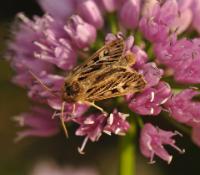
Class Name: Tacoma Polia
Scientific Name: Trichordestra tacoma
Found in (N=Newfoundland, L=Labrador):
Host Plant:
Nectar Source: Thimbleberry (Rubus); willow, Epilobium, Prunus, Sambucus, Vaccinium myrtilloides, Spiraea latifolia, White birch (Betula papyrifera), dogbane (Apocynum androsaemifolium)
Class Name: Two-spot Dart
Scientific Name: Eueretagrotis perattenta
Found in (N=Newfoundland, L=Labrador): NL
Host Plant:
Nectar Source:
Class Name: American Brindle
Scientific Name: Lithomoia Xestia
Found in (N=Newfoundland, L=Labrador):
Host Plant:
Nectar Source:
Class Name:
Scientific Name: Xestia oblata
Found in (N=Newfoundland, L=Labrador):
Host Plant:
Nectar Source:
Class Name: Boomerang Dart
Scientific Name: Xestia perquiritata
Found in (N=Newfoundland, L=Labrador): NL
Host Plant:
Nectar Source:
Erebid Moths (Erebidae)
Class Name: Virginia Ctenucha
Scientific Name: Ctenucha virginica
Found in (N=Newfoundland, L=Labrador): NL
Host Plant: Grasses, irises, sedges
Nectar Source:

Class Name: Spotted Tussock Moth or Yellow-Spotted Tiger Moth
Scientific Name: Lophocampa maculata
Found in (N=Newfoundland, L=Labrador): NL
Host Plant: Birches, maples, oaks, poplars, willows
Nectar Source:
Class Name: St. Lawrence Tiger Moth
Scientific Name: Platarctia parthenos
Found in (N=Newfoundland, L=Labrador): NL
Host Plant: Alder, birches, lettuce, willows, and other plants
Nectar Source:
Class Name: Virginian Tiger Moth or Yellow Woolybear Moth
Scientific Name: Spilosoma virginica
Found in (N=Newfoundland, L=Labrador): N
Host Plant:
Nectar Source:
Class Name: (White) Satin Moth
Scientific Name: Leucoma salicis
Found in (N=Newfoundland, L=Labrador): N
Host Plant:
Nectar Source:
Class Name: Rusty Tussock Moth
Scientific Name: Orgyia antiqua
Found in (N=Newfoundland, L=Labrador): N
Host Plant: Generalist feeders on the foliage of flowering trees in the Rosaceae, Fagaceae, Ericaceae, and Salicaceae
Nectar Source:
Class Name: White-marked Tussock Moth
Scientific Name: Orgyia leucostigma
Found in (N=Newfoundland, L=Labrador): N
Host Plant: Over 140 known hosts, including alder, apple, balsam fir, birches, and larch
Nectar Source:
Crambid Snout Moths (Crambidae)
Class Name: Wide-stripe Grass-veneer Moth
Scientific Name: Crambus unistriatellus
Found in (N=Newfoundland, L=Labrador):
Host Plant: Grasses, grass roots (Poaceae)
Nectar Source:
Class Name: Small Magpie
Scientific Name: Eurrhypara hortulata
Found in (N=Newfoundland, L=Labrador):
Host Plant: Urtica, Mentha, Stachys, Galeopsis, Marrubium, Convolvulus, Ribes
Nectar Source:
Pterophorid Moths, Plume Moths (Pterophoridae)
Class Name: Morning-glory Plume Moth
Scientific Name: Emmelina monodactyla
Found in (N=Newfoundland, L=Labrador):
Host Plant:
Nectar Source:

Geometer Moths, Looper Moths (Geometridae)
Class Name: Pale Beauty
Scientific Name: Campaea perlata
Found in (N=Newfoundland, L=Labrador): NL
Host Plant:
Nectar Source:
Class Name: Hemlock Looper
Scientific Name: Lambdina fiscellaria
Found in (N=Newfoundland, L=Labrador): NL
Host Plant: Firs, hemlocks, oaks, and spruces
Nectar Source:
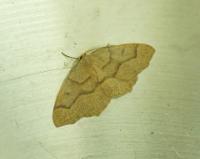
Class Name: Pale Metanema
Scientific Name: Metanema inatomaria
Found in (N=Newfoundland, L=Labrador): N
Host Plant:
Nectar Source:
Class Name: Large Maple Spanworm Moth
Scientific Name: Prochoerodes lineola
Found in (N=Newfoundland, L=Labrador): N
Host Plant:
Nectar Source:
Class Name: Sharp-lined Yellow
Scientific Name: Sicya macularia
Found in (N=Newfoundland, L=Labrador): N
Host Plant:
Nectar Source:
Class Name: Dark Marbled Carpet
Scientific Name: Dysstroma citrata
Found in (N=Newfoundland, L=Labrador): NL
Host Plant:
Nectar Source:
Class Name: White-banded Black
Scientific Name: Rheumaptera subhastata
Found in (N=Newfoundland, L=Labrador): NL
Host Plant: Alder
Nectar Source:
Class Name: White-striped Black
Scientific Name: Trichodezia albovittata
Found in (N=Newfoundland, L=Labrador): N
Host Plant: Impatiens
Nectar Source:
Class Name: Welsh Wave
Scientific Name: Venusia cambrica
Found in (N=Newfoundland, L=Labrador): NL
Host Plant: Leaves of mountain-ash, alder, apple, birch, mountain ash, serviceberry and willow
Nectar Source:
Hawk Moths, Sphinx Moths, & Hornworms (Sphingidae)
Class Name: Hummingbird Moth
Scientific Name: Hemaris diffinis
Found in (N=Newfoundland, L=Labrador): N (L?)
Host Plant: Honeysuckle, viburnum, hawthorn, snowberry, cherry, mint, and plum
Nectar Source: Dwarf bush honeysuckle, snowberry, orange hawkweed, thistles, lilac, and Canada violet
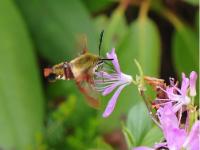
Class Name: Laurel Sphinx
Scientific Name: Sphinx kalmiae
Found in (N=Newfoundland, L=Labrador): N
Host Plant: Mountain laurel, lilac, mountain holly
Nectar Source: Honeysuckle, and bouncing bet
*Photos courtesy of Todd Boland, Research Horticulturist with MUN Botanical Garden
*Text source adapted from:
- Department of Fisheries and Land Resources, Government of Newfoundland and Labrador
Additional text from:
- Butterflies and Moths (.org) website
- Butterflies and moths of Newfoundland and Labrador : the macrolepidoptera by Ray F. Morris
